Integrated Analysis of Rockfalls and Floods in the Jiului Gorge, Romania: Impacts on Road and Rail Traffic
Abstract
1. Introduction
2. Materials and Methods
3. Results
3.1. Flood Mapping
3.2. Rockfall Mapping
3.3. Susceptibility Maps
- The GIS-Based Approach Combined Various Datasets and Techniques to Assess Susceptibility to Floods and Rockfalls.
- Digital Elevation Model (DEM) Analysis: DEM Data Provided Elevation Information for Terrain Classification into Low, Moderate, and High Slope Gradients, Indicating Erosion and Instability Risks (Guzzetti et al., 2006 [19]).
- Flow Direction and Accumulation: Hydrological Models Identified Drainage Patterns and Potential Runoff Pathways (Tarolli and Tarboton 2006 [20]).
- NDVI Calculations: NDVI from Satellite Imagery Assessed Vegetation Cover and Its Influence on Slope Stability (Pettorelli et al., 2005 [12]).
- Weighted Overlays: Integration of DEM-Derived Slope Classifications, Land Cover Types, and Proximity to Water Bodies Produced Comprehensive Susceptibility Maps.
3.4. Traffic Detection Using AI
4. Discussion
4.1. Insights from Integrated Analysis
4.2. Effectiveness of Sentinel-1 Radar Imagery
4.3. Validation of Models
4.4. Implications of Susceptibility Maps
4.5. AI Model Performance and Future Directions
4.6. Challenges and Future Research
5. Conclusions
Author Contributions
Funding
Institutional Review Board Statement
Informed Consent Statement
Data Availability Statement
Acknowledgments
Conflicts of Interest
References
- Brakenridge, G.R.; Anderson, E.; Nghiem, S.V.; Caquard, S.; Shabaneh, T.B. Flood warnings, flood disaster assessments, and flood hazard reduction: The roles of orbital remote sensing. In Proceedings of the 30th International Symposium on Remote Sensing of Environment, Honolu, HI, USA, 10–14 November 2003. [Google Scholar]
- Didovets, I.; Krysanova, V.; Bürger, G.; Snizhko, S.; Balabukh, V.; Bronstert, A. Climate change impact on regional floods in the Carpathian region. J. Hydrol. Reg. Stud. 2019, 22, 100590. [Google Scholar] [CrossRef]
- Zoccatelli, D.; Borga, M.; Zanon, F.; Antonescu, B.; Stancalie, G. Which rainfall spatial information for flash flood response modelling? A numerical investigation based on data from the Carpathian range, Romania. J. Hydrol. 2010, 394, 148–161. [Google Scholar] [CrossRef]
- Žabota, B.; Repe, B.; Kobal, M. Influence of digital elevation model resolution on rockfall modelling. Geomorphology 2019, 328, 183–195. [Google Scholar] [CrossRef]
- Žabota, B.; Trappmann, D.; Levanič, T.; Kobal, M. Reconstruction of rockfall activity through dendrogeomorphology and a scar-counting approach: A study in a beech forest stand in the Trenta valley (Slovenian Alps). Acta Silvae Ligni 2020, 121, 19–32. [Google Scholar] [CrossRef]
- Zhang, X.; Fu, Q.; Li, Y.; Han, Z.; Jiang, N.; Li, C. A Dynamic Detection Method for Railway Slope Falling Rocks Based on the Gaussian Mixture Model Segmentation Algorithm. Appl. Sci. 2024, 14, 4454. [Google Scholar] [CrossRef]
- Pánek, T.; Engel, Z.; Mentlík, P.; Braucher, R.; Břežný, M.; Škarpich, V.; Zondervan, A. Cosmogenic age constraints on post-LGM catastrophic rock slope failures in the Tatra Mountains (Western Carpathians). CATENA 2016, 138, 52–67. [Google Scholar] [CrossRef]
- Zhang, Z.; Chen, P.; Huang, Y.; Dai, L.; Xu, F.; Hu, H. Railway obstacle intrusion warning mechanism integrating YOLO-based detection and risk assessment. J. Ind. Inf. Integr. 2024, 38, 100571. [Google Scholar] [CrossRef]
- Tao, J.; Wang, H.; Zhang, X.; Li, X.; Yang, H. An object detection system based on YOLO in traffic scene. In Proceedings of the 2017 6th International Conference on Computer Science and Network Technology (ICCSNT), Dalian, China, 21–22 October 2017. [Google Scholar] [CrossRef]
- Amitha, I.C.; Narayanan, N.K. Object Detection Using YOLO Framework for Intelligent Traffic Monitoring. In Machine Vision and Augmented Intelligence—Theory and Applications; Springer: Singapore, 2021. [Google Scholar] [CrossRef]
- Al-qaness, M.A.A.; Abbasi, A.A.; Fan, H.; Ibrahim, R.A.; Alsamhi, S.H.; Hawbani, A. An improved YOLO-based road traffic monitoring system. Computing 2021, 103, 211–230. [Google Scholar] [CrossRef]
- Pettorelli, N.; Vik, J.O.; Mysterud, A.; Gaillard, J.-M.; Tucker, C.J.; Stenseth, N. Chr. Using the satellite-derived NDVI to assess ecological responses to environmental change. rends Ecol. Evol. 2005, 20, 503–510. [Google Scholar] [CrossRef]
- Gosar, A. The size of the area affected by earthquake induced rockfalls: Comparison of the 1998 Krn Mountains (NW Slovenia) earthquake (Mw 5.6) with worldwide data. Acta Geogr. Slov. 2019, 59, 51–61. [Google Scholar] [CrossRef]
- Parajka, J.; Kohnová, S.; Bálint, G.; Barbuc, M.; Borga, M.; Claps, P.; Cheval, S.; Dumitrescu, A.; Gaume, E.; Hlavčová, K.; et al. Seasonal characteristics of flood regimes across the Alpine–Carpathian range. J. Hydrol. 2010, 394, 78–89. [Google Scholar] [CrossRef] [PubMed]
- Bin Zuraimi, M.A.; Kamaru Zaman, F.H. Vehicle Detection and Tracking using YOLO and DeepSORT. In Proceedings of the 2021 IEEE 11th IEEE Symposium on Computer Applications & Industrial Electronics (ISCAIE), Penang, Malaysia, 3–4 April 2021. [Google Scholar] [CrossRef]
- Stumpf, A.; Malet, J.-P.; Kerle, N.; Niethammer, U.; Rothmund, S. Image-based mapping of surface fissures for the investigation of landslide dynamics. Geomorphology 2013, 186, 12–27. [Google Scholar] [CrossRef]
- Gunnell, Y.; Blondeau, S.; Jarman, D. Rock slope failure in the Southern Carpathians (Romania): Range-wide inventory and links with long-term mountain landscape evolution. Geomorphology 2022, 418, 108433. [Google Scholar] [CrossRef]
- Fidej, G.; Mikos, M.; Rugani, T.; Jez, J.; Kumelj, S.; Diaci, J. Assessment of the protective function of forests against debris flows in a gorge of the Slovenian Alps. Iforest-Biogeosci. For. 2014, 8, 73–81. [Google Scholar] [CrossRef]
- Guzzetti, F.; Galli, M.; Reichenbach, P.; Ardizzone, F.; Cardinali, M. 2006: Landslide hazard assessment in the Collazzone area, Umbria, Central Italy. Nat. Hazards Earth Syst. Sci. 2006, 6, 115–131. [Google Scholar] [CrossRef]
- Tarolli, P.; Tarboton, D.G. A new method for determination of most likely landslide initiation points and the evaluation of digital terrain model scale in terrain stability mapping. Hydrol. Earth Syst. Sci. 2006, 10, 663–677. [Google Scholar] [CrossRef]
- Venegas-Cordero, N.; Kundzewicz, Z.W.; Jamro, S.; Piniewski, M. Detection of trends in observed river floods in Poland. J. Hydrol. Reg. Stud. 2022, 41, 101098. [Google Scholar] [CrossRef]
- Yang, W.; Zhang, W. Real-time Traffic Signs Detection Based on YOLO Network Model. In Proceedings of the 2020 International Conference on Cyber-Enabled Distributed Computing and Knowledge Discovery (CyberC), Chongqing, China, 29–30 October 2020. [Google Scholar] [CrossRef]
- Zoumpekas, T.; Puig, A.; Salamó, M.; García-Sellés, D.; Blanco Nuñez, L.; Guinau, M. An intelligent framework for end-to-end rockfall detection. Int. J. Intell. Syst. 2021, 36, 6471–6502. [Google Scholar] [CrossRef]
- Azimjonov, J.; Özmen, A. A real-time vehicle detection and a novel vehicle tracking systems for estimating and monitoring traffic flow on highways. Adv. Eng. Inform. 2021, 50, 101393. [Google Scholar] [CrossRef]
- Lin, C.-J.; Jhang, J.-Y. Intelligent Traffic-Monitoring System Based on YOLO and Convolutional Fuzzy Neural Networks. IEEE Access 2022, 10, 14120–14133. [Google Scholar] [CrossRef]
- Bălteanu, D.; Jurchescu, M.; Surdeanu, V.; Ionita, I.; Goran, C.; Urdea, P.; Rădoane, M.; Sima, M. Recent Landform Evolution in the Romanian Carpathians and Pericarpathian Regions. In Recent Landform Evolution: The Carpatho-Balkan-Dinaric Region; Springer: Dordrecht, The Netherlands, 2021. [Google Scholar] [CrossRef]
- Ovreiu, A.-B.; Oprea, C.-R.; Andra-Topârceanu, A.; Pintilii, R.-D. Dendrogeomorphological Reconstruction of Rockfall Activity in a Forest Stand, in the Cozia Massif (Southern Carpathians, Romania). Forests 2024, 15, 122. [Google Scholar] [CrossRef]
- Nguyen, Q.-K.; Tien Bui, D.; Hoang, N.-D.; Trinh, P.T.; Nguyen, V.-H.; Yilmaz, I. A Novel Hybrid Approach Based on Instance Based Learning Classifier and Rotation Forest Ensemble for Spatial Prediction of Rainfall-Induced Shallow Landslides using GIS. Sustainability 2017, 9, 813. [Google Scholar] [CrossRef]
- Malczewski, J. GIS-based multicriteria decision analysis: A survey of the literature. Int. J. Geogr. Inf. Sci. 2006, 20, 703–726. [Google Scholar] [CrossRef]
- Tošić, R.; Dragićević, S.; Zorn, M.; Lovrić, N. Landslide susceptibility zonation: A case study of the Municipality of Banja Luka (Bosnia and Herzegovina). Acta Geogr. Slov. 2014, 54, 190–202. [Google Scholar] [CrossRef]
- Ćorović, A.; Ilić, V.; Ðurić, S.; Marijan, M.; Pavković, B. The Real-Time Detection of Traffic Participants Using YOLO Algorithm. In Proceedings of the 2018 26th Telecommunications Forum (TELFOR), Belgrade, Serbia, 20–21 November 2018. [Google Scholar] [CrossRef]
- Mreyen, A.-S.; Cauchie, L.; Micu, M.; Onaca, A.; Havenith, H.-B. Multiple geophysical investigations to characterize massive slope failure deposits: Application to the Balta rockslide. Geophys. J. Int. 2021, 225, 1032–1047. [Google Scholar] [CrossRef]
- Petje, U.; Ribičič, M.; Mikoš, M. Computer simulation of stone falls and rockfalls. Acta Geogr. Slov. 2005, 45, 93–120. [Google Scholar] [CrossRef]
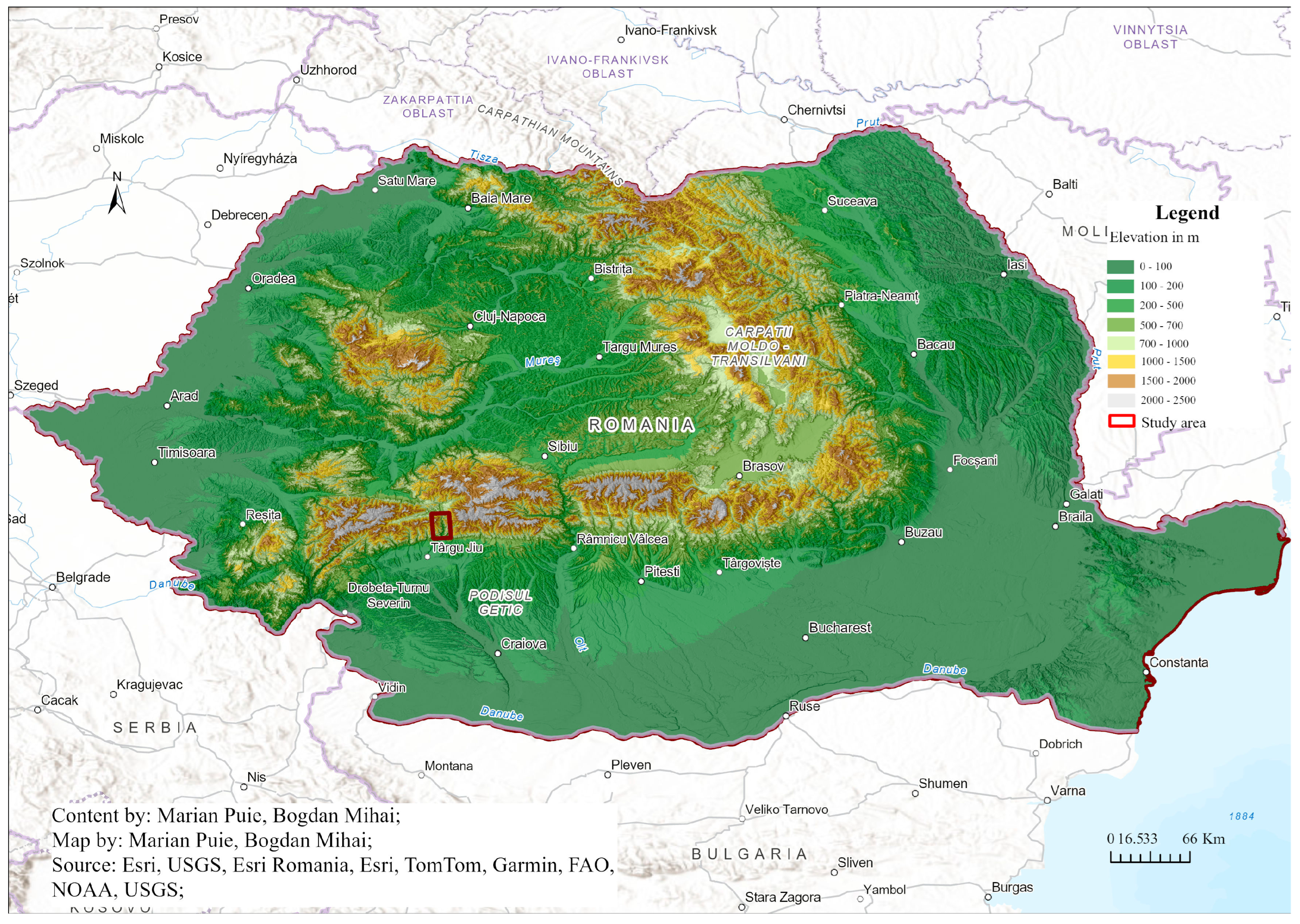

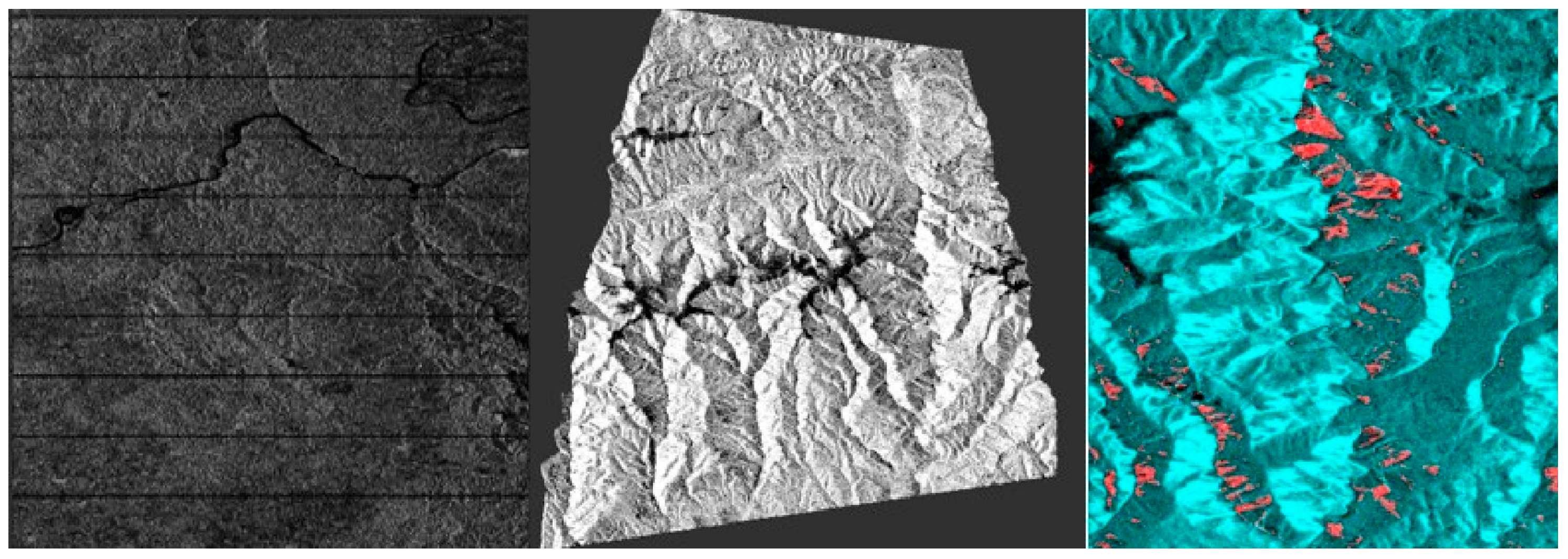
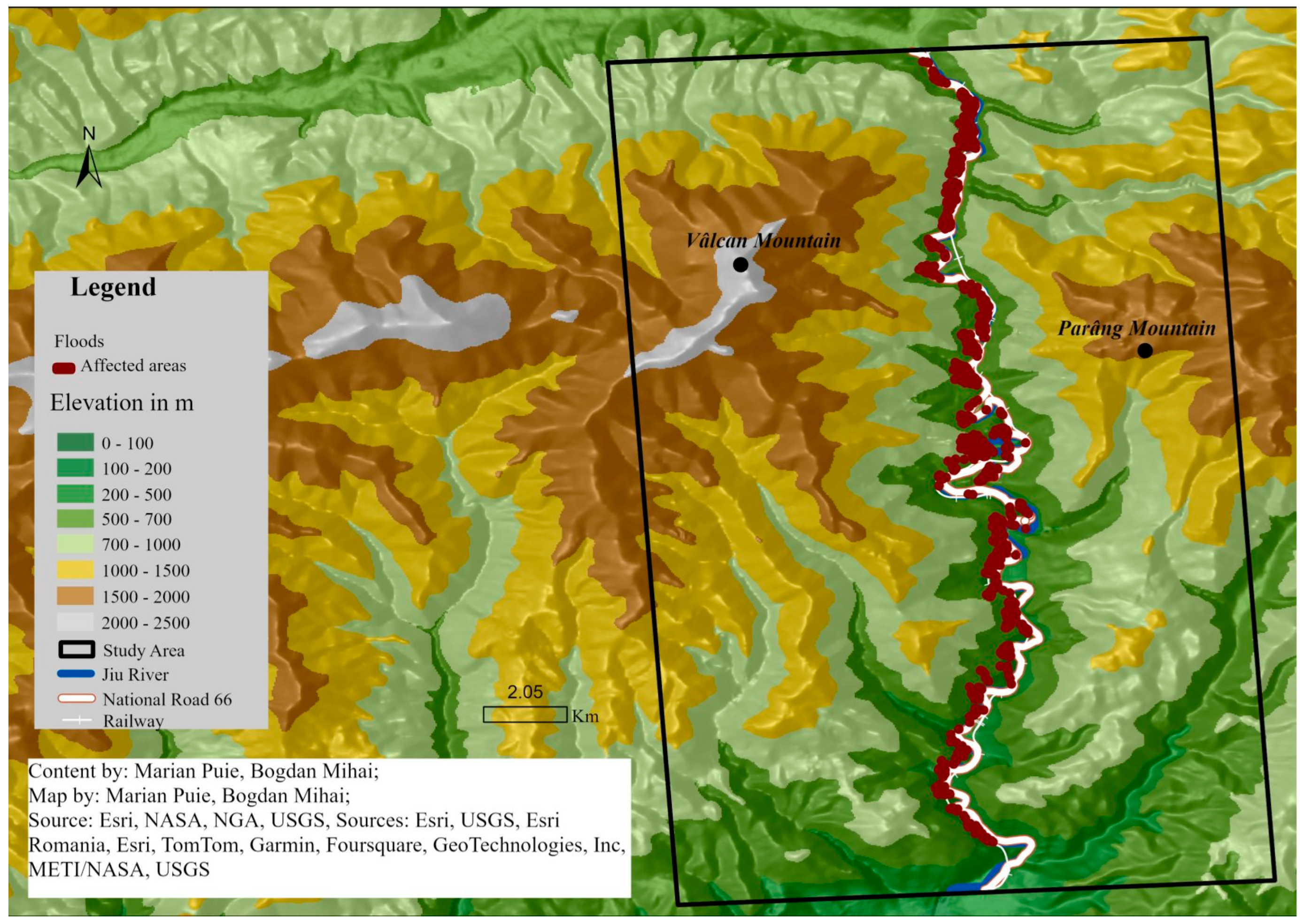
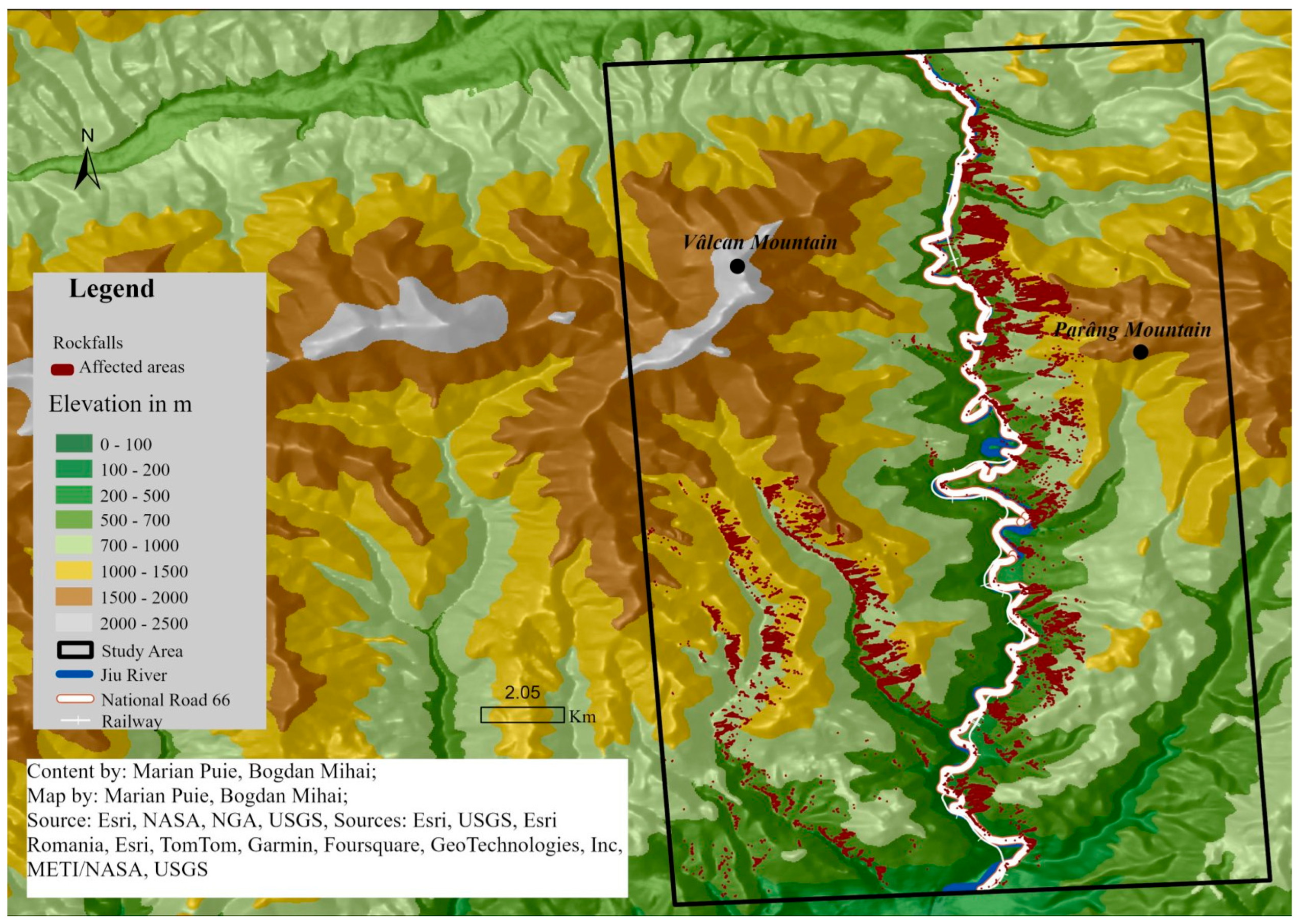




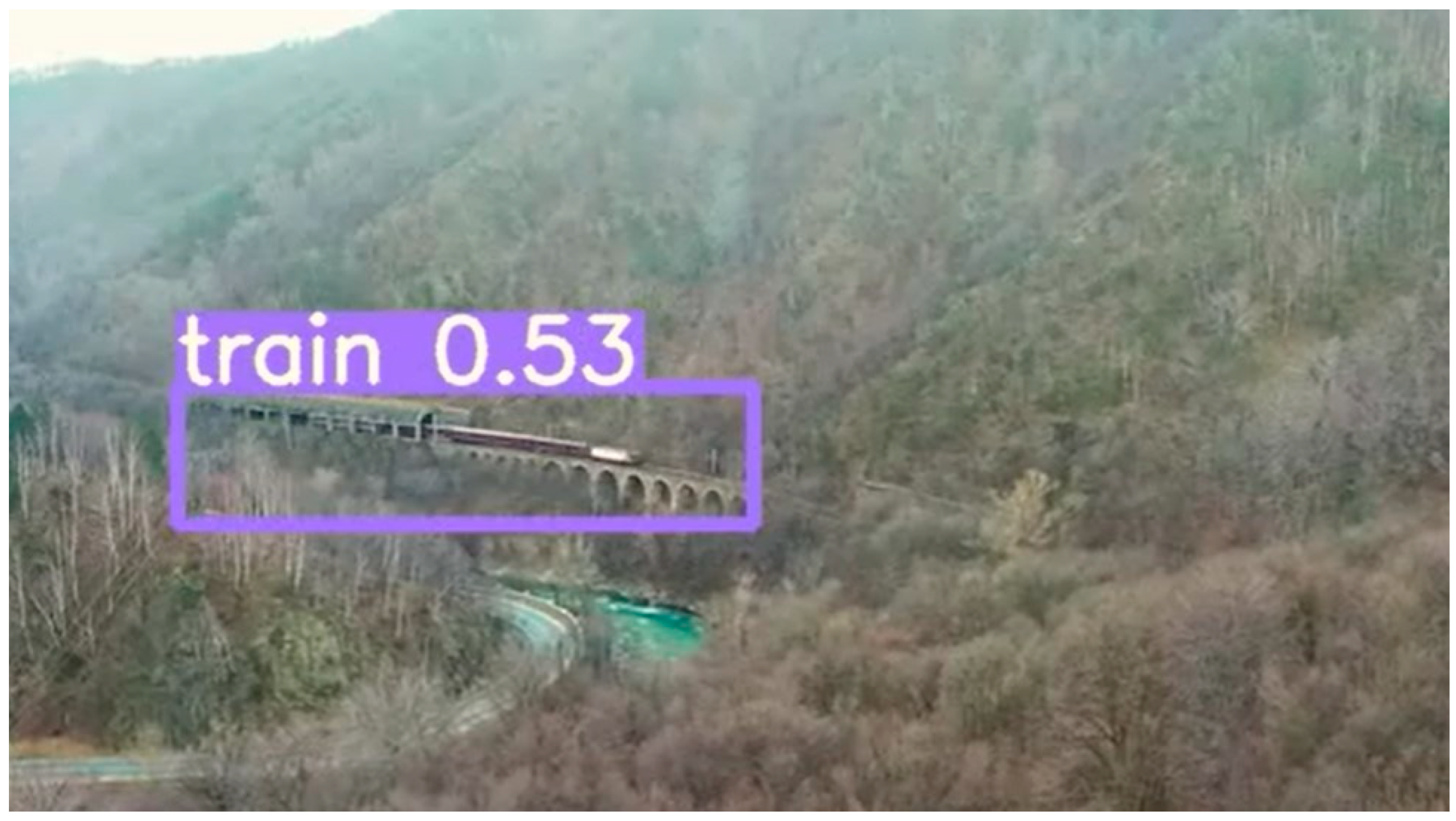




Disclaimer/Publisher’s Note: The statements, opinions and data contained in all publications are solely those of the individual author(s) and contributor(s) and not of MDPI and/or the editor(s). MDPI and/or the editor(s) disclaim responsibility for any injury to people or property resulting from any ideas, methods, instructions or products referred to in the content. |
© 2024 by the authors. Licensee MDPI, Basel, Switzerland. This article is an open access article distributed under the terms and conditions of the Creative Commons Attribution (CC BY) license (https://creativecommons.org/licenses/by/4.0/).
Share and Cite
Puie, M.; Mihai, B.-A. Integrated Analysis of Rockfalls and Floods in the Jiului Gorge, Romania: Impacts on Road and Rail Traffic. Appl. Sci. 2024, 14, 10270. https://doi.org/10.3390/app142210270
Puie M, Mihai B-A. Integrated Analysis of Rockfalls and Floods in the Jiului Gorge, Romania: Impacts on Road and Rail Traffic. Applied Sciences. 2024; 14(22):10270. https://doi.org/10.3390/app142210270
Chicago/Turabian StylePuie, Marian, and Bogdan-Andrei Mihai. 2024. "Integrated Analysis of Rockfalls and Floods in the Jiului Gorge, Romania: Impacts on Road and Rail Traffic" Applied Sciences 14, no. 22: 10270. https://doi.org/10.3390/app142210270
APA StylePuie, M., & Mihai, B.-A. (2024). Integrated Analysis of Rockfalls and Floods in the Jiului Gorge, Romania: Impacts on Road and Rail Traffic. Applied Sciences, 14(22), 10270. https://doi.org/10.3390/app142210270






